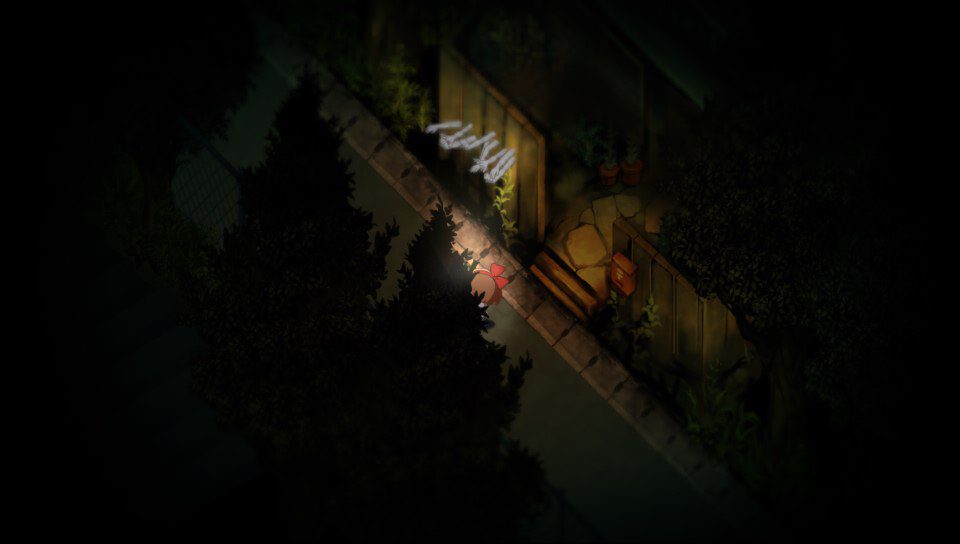Horror is something that’s not easy to pull off in any medium. Lucky for gamers its a little easier in the world of video games, if not a spectacle with more parts to use. Putting the player in the role of the character involved in the scary situation can take something that’s fairly tame in a movie and make it absolutely horrifying in a game. It’s wild how that little bit of interactivity affects the psyche and when the developer is aware of this, true horror can be attained. Yomawari: Night Alone for the PSVita is an attempt at true horror with Japanese themes and mythology that tells the story of a little girl searching for her lost sister in a twisted, nightmarish town.
Yomawari puts the player in the role of a little girl who wanders a Japanese town in search of her sister and her lost dog. As she wanders through the town at night looking for clues to her sister’s whereabouts, creatures start materializing out of the darkness. Avoiding these nightmares is paramount in the girl’s survival as a single hit will kill her, so players must learn their enemies and how to avoid them properly.
The entire game is shown from a top-down perspective, with a high emphasis on lighting. Our hero is armed with little to keep the nightmares away, but she does have a flashlight that allows her to see certain creatures or keep some of them from moving. Running away is a must, as most of these creatures will chase her down on sight. At the bottom of the screen is a stamina bar like many games, but the more afraid the girl becomes, the faster the bar will deplete. Knowing when to run and when to just keep moving will help keep the girl alive.

These chase scenes provide some of the best examples of tension in Yomawari. Some of the most exciting moments in my time with the game was while wandering the streets, unaware of danger. That’s when I would notice just a sliver of an enemy monster on the light cast behind the girl. Couple this situational horror with the game’s jump scare tactics and the fact our girl is incredibly weak makes for an interesting adventure.
The little girl does get a few tools to help her out along the way. Picking up stones allows her to toss them to distract monsters, while picking up coins allows her to make an offering to the statues strewn about the town. These statues are temporary saves and teleportation spots that are connected to other statues. This is great for getting around the town quickly, as the simple task of walking down the street is quite dangerous. Lastly, our heroic little girl can hide in bushes and behind signs. Doing so blacks out all but her on the screen, with a hazy red aura representing the monsters floating about. To survive this, players must listen to the creature’s movements and the girl’s heartbeat. Exiting at the right time can be the difference between life and death.
In the first act, Yomawari is filled with scripted jump scares and dark surprises. I was a little turned off by it, until the game started to develop. In the second chapter or so, the player must actually explore the town to find items and keys to trigger certain events. For example, one section has the girl find her sister’s shoe, but a strange human-faced dog has taken it away. After finding several keys to a few areas the player eventually uncovers a bone, which they can use to distract the dog. Through this area, these ridiculously fast dogs pop out of the woods, forcing the player to hide for at least a moment.

Now, while the literal scares provide for some tense gameplay moments, the themes and imagery in Yomawari hits that uncanny spot in the liver that Japanese horror often hits. Some of the monster designs in this game are something straight out of Lovecraft if he lived in Tokyo. Not everything is as it seems, trust me. I came across a little cat at one point and I followed it, only to have it change into a giant cat head that ate me. Ten minutes later I swear I saw a monster floating just outside the girl’s house, but it disappeared when I pointed the flash light at it or walked near.
There are also some pretty complex themes at work in the game’s plot. Yomawari is a story about death and how this little girl comprehends it, as well as her denial of it. It’s also her refusal to die and her journey to save those close to her, all while growing up fast in a dark, scary world that’s quick to eat her up. The symbolism here is pretty interesting to say the least.
Yomawari is filled with these weird instances and dark imagery. It’s the type of horror that really sticks with you, especially given its fairly simple presentation. If I were to compare it to another game, Yomawari reminds me a lot of those RPG Maker horror games like Misao or Blank Dream. These games use situational horror and surprise, rather than detailed gore or grotesque imagery, especially considering their limited engines.

While Yomawari really did have some excellent horror moments in it and I can’t wait to see how it ends, there are some downsides to the game. For starters, dying happens incredibly frequently. Which isn’t so bad if the player remembers to offer coins to the statues, since they just pop the girl back into existence. Yet, in some instances I struggled getting to where I needed to be because a monster faster than me kept spawning in my path. This also makes it hard to explore the town, which is actually spooky by itself, even if a lot of it looks the same. If I were to pick one thing to improve Yomawari at all, it would be to have less creatures to create more atmosphere.
Yomawari also has plenty of side items to collect for those into completing the scrapbook in the game, which can make playing it take more time. Doing so provides with some interesting moments, but picking up these items or going out of the way of the main objective is not required to complete the main game, which can be completed fairly quickly provided the player doesn’t get lost.

Overall, Yomawari: Night Alone is a cool, experimental type of horror game that just wouldn’t work on any console but the Vita. The game looks great on the Vita, really making the splendid artwork pop out. It’s also easy to dedicate an hour or so to get to the next save area and put it down, perfect for gaming on the go. There was a moment I had to look up a guide to find the key to start a line of finding other keys, so the game can be fairly hard in how it hides things sometimes. Vita players should definitely pick this one up though, as there isn’t really anything like Yomawari on the console. There are some flaws here and there, but it’s mostly a balance issue and the want for the world to be expanded upon. It is a fairly small game in scope compared to most, but there is a ton of scary charm to be had.
Yomawari: Night Alone is a unique example of Japanese horror on the Vita, but there are some lacking areas in its design. Even with that, I wholeheartedly recommend picking it up.
Yomawari: Night Alone is available digitally as well as physically on the Vita. The physical release also comes packaged with htoL#NiQ: The Firefly Diary, which is another game about a little girl in a strange world. PC players can also pick it up on Steam. Collectors can also check out the limited edition, which has a ton of goodies.





